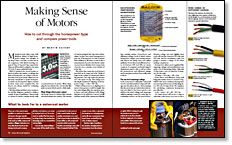Making Sense of Motors
How to cut through the horsepower hype and compare power tools
Synopsis: When you see terms like “maximum” or “peak” horsepower, watch out, Martin Seifert says. Those terms aren’t complete lies, but they’re not useful. Woodworking machines aren’t meant to be pushed to near meltdown. Look at the fine print and do a little math when shopping for motorized tools. Seifert explains what affects power output – horsepower, power factor, and efficiency, as well as length of wire, outlets and extension cords, and the condition of that equipment. You can trust the amperage ratings, but knowing how these claims are made helps prolong a machine’s life. Seifert, who works in the automation and power plant generation industries, shows how to decipher the nameplate information on an industrial motor and how to do a checkup for power tools. He also explains what to look for in a universal motor.
Motorized tools often come with fabulous claims of high horsepower ratings. For example, in my shop I have a vacuum, a router and an air compressor with labels boasting outputs of 3 hp, 3.5 hp and 5 hp, respectively. They are all intended to plug into the same 115-volt, 15-amp residential outlet.
Well, if I jammed the circuit breaker so that it wouldn’t trip, maybe I could get that kind of horsepower out of these tools before they went up in smoke. When you see the terms “maximum” or “peak” horsepower, watch out. Horsepower claims couched in those terms aren’t complete lies, but they’re not always useful for evaluating true power.
Woodworking machines aren’t meant to be run like dragsters, pushed to within a couple of rpm of meltdown. They’re built to operate at steady cruising speeds with occasional bursts of power. When shopping for motorized tools, I look at the fine print on motor labels and do a little math.
Many things affect power output
An electric motor is a device that converts electrical energy into motion. The amount of current pumped into that motor determines, in part, how much horsepower it puts out. A horsepower is a unit of power that’s defined as 746 watts. A watt is also a measurement of power; the electric meter on your house tabulates how many watts of power you consume every minute of every day.
The power that comes into your house is parceled out in amps and volts. Think of amps as the volume of current and volts as the pressure. One amp under the pressure of 1 volt equals 1⁄746 hp. That brings us to the simple equation for figuring out horsepower: (amps volts) ÷ 746 = hp.
If that’s all there were to it, figuring out a motor’s horsepower would be simple. But two other things affect the equation: power factor (pf) and efficiency (eff), things that have to do with how a motor is built and how much of the current goes directly into creating motion. Power-factor and efficiency ratings—both of which reduce horsepower output—vary among motors, and they’re not things most tool sellers publicize. Power-factor and efficiency losses of between 10% and 30% are pretty common. A company’s technical-support department may be able to tell you what the power-factor and efficiency ratings are for any given product if you really want to know.
From Fine Woodworking #135
For the full article, download the PDF below:
Fine Woodworking Recommended Products

Jorgensen 6 inch Bar Clamp Set, 4 Pack

Tite-Mark Marking Gauge

Ridgid EB4424 Oscillating Spindle/Belt Sander






















Log in or create an account to post a comment.
Sign up Log in